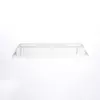Mobile:+86-311-808-126-83
Email:info@ydcastings.com
casting aluminum
The Art and Science of Casting Aluminum An Overview
Aluminum casting is a celebrated method for creating complex shapes and components used in various industries, including aerospace, automotive, and consumer products. This remarkable process leverages the unique properties of aluminum and allows manufacturers to achieve precision, durability, and lightweight designs. In this article, we will explore the fundamentals of aluminum casting, its techniques, benefits, and applications, illustrating why it's a vital manufacturing process in today’s world.
Understanding Aluminum Casting
At its core, aluminum casting involves pouring molten aluminum into a mold, allowing it to cool and solidify into the desired shape. The two primary forms of aluminum casting are sand casting and die casting. Each method has its own advantages, disadvantages, and applications, making it essential for manufacturers to choose the right process based on their specific requirements.
Sand Casting
Sand casting is one of the oldest and most versatile metal casting processes. In this method, a mold is formed from a mixture of sand and a binding agent. Once the mold is created, molten aluminum is poured into the cavity. After the aluminum cools and solidifies, the mold is broken away to reveal the cast component.
Sand casting is favored for its ability to produce large and intricate parts, making it ideal for low-volume production or prototyping. However, it may lack the dimensional precision of other methods, which can be a consideration for certain applications.
Die Casting
Die casting, on the other hand, involves forcing molten aluminum under high pressure into reusable metal molds or dies. This technique allows for high-volume production with exceptional dimensional accuracy and surface finish. As a result, die casting is widely used for manufacturing small to medium-sized parts that require precision, such as automotive components and electronic housings.
Advantages of Aluminum Casting
casting aluminum

The choice of aluminum as a casting material offers numerous advantages. Firstly, aluminum is lightweight, which is crucial in automotive and aerospace applications where reducing weight can significantly enhance efficiency and performance. Furthermore, aluminum has excellent corrosion resistance, making parts more durable and extending their lifespan, especially in challenging environments.
Aluminum is also highly malleable and can be easily shaped into various forms, allowing for complex designs that may not be achievable with other materials. Additionally, the thermal and electrical conductivity of aluminum makes it an ideal choice for applications requiring efficient heat dissipation or electrical conduction.
Applications of Aluminum Casting
The versatility of aluminum casting enables its application across a wide range of industries. In the automotive sector, for instance, aluminum castings are used for engine blocks, cylinder heads, and transmission cases. These lightweight components help improve vehicle fuel efficiency and performance while maintaining strength.
In aerospace, aluminum castings are utilized in various structural and non-structural components, such as aircraft wings and engine casings, where every gram saved contributes to fuel efficiency and payload capacity. Similarly, the consumer electronics industry benefits from aluminum casting for producing lightweight and durable housings that protect delicate components.
The Future of Aluminum Casting
As technology advances, the aluminum casting process continues to evolve. Innovations such as computer-aided design (CAD) and simulation software enhance mold design, allowing engineers to predict potential casting defects and optimize the process before production. Moreover, advancements in recycling technology are making aluminum casting even more sustainable, as aluminum is one of the most recyclable materials available.
Furthermore, as industries worldwide become more focused on sustainability and reducing carbon footprints, aluminum’s recyclability and lightweight properties position it as an ideal choice for future manufacturing. Increased research into additive manufacturing techniques, such as 3D printing, may also lead to exciting developments in aluminum casting methods.
Conclusion
The art and science of aluminum casting is an indispensable process that encompasses a blend of tradition and modern innovation. Its ability to produce lightweight, durable, and intricately designed components makes it a preferred choice in numerous industries. As manufacturers continue to explore new technologies and sustainable practices, the future of aluminum casting shines brightly, promising new possibilities and advancements that will create a lasting impact across various sectors. Whether for automotive applications or aerospace engineering, aluminum casting will remain a key player in the manufacturing landscape for years to come.
-
Impeller Technology That Powers Precision in Pump SystemsNewsMay.22,2025
-
Valve Durability Begins with Quality Cast Iron ComponentsNewsMay.22,2025
-
Performance Cooling with Advanced Automobile Water Pump SolutionsNewsMay.22,2025
-
How Motor Housing and Oil Pans Shape Engine PerformanceNewsMay.22,2025
-
How Metal Castings Drive Modern Manufacturing EfficiencyNewsMay.22,2025
-
Exploring the Engineering Behind Valve Body CastingsNewsMay.22,2025











